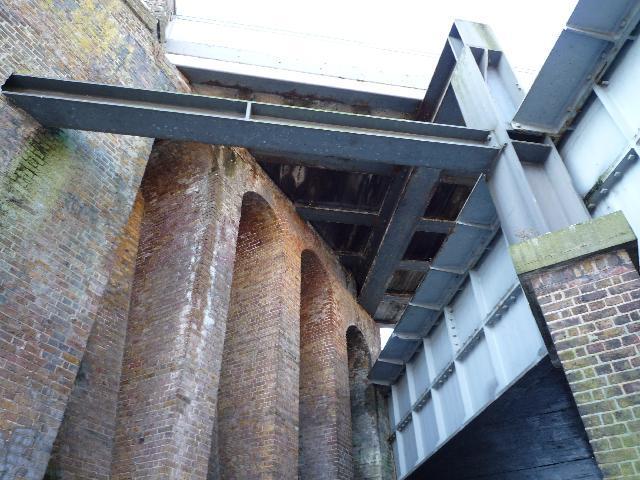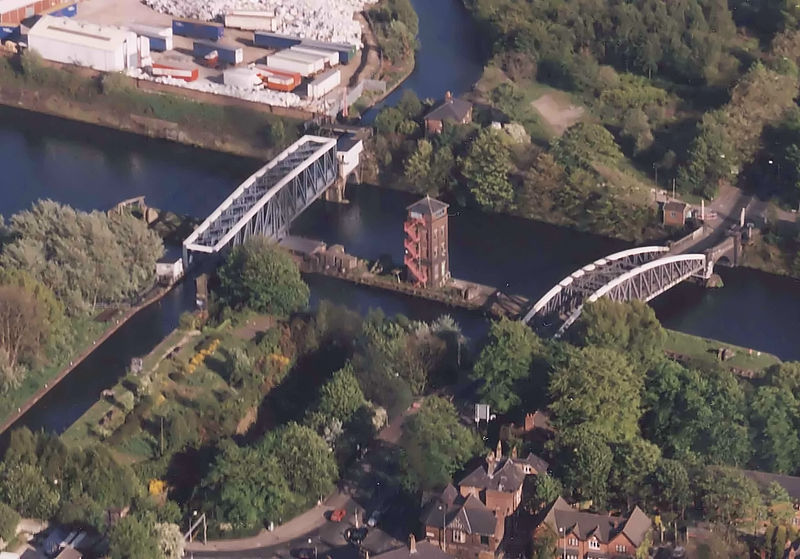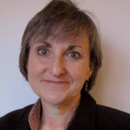Navigable aqueduct

|
| The Edstone Aqueduct was opened in 1816 to carry the Stratford-upon-Avon Canal across a shallow valley of meadows, the railway, a road and a stream. This cast iron aqueduct's towpath is part of the iron trough, so pedestrians get a "duck's eye" view of passing canal boats. |
Contents |
[edit] Introduction
Navigable aqueducts (sometimes called water bridges or canal aqueducts) are structures that incorporate canals above other waterways, valleys or transportation infrastructure. Since they function as canals for transport, navigable aqueducts are generally wider than traditional aqueducts.
[edit] History
While elevated water bridges were used during by Roman Empire, aqueducts were not regularly used as transport systems until the 17th century, when modern canal systems were introduced as a form of transportation. In Great Britain, navigable aqueducts became an important part of the country’s industrial revolution.
However, water bridges in the sky were not popular with early canal builders who used masonry for their structures. The weight of the water, and the clay required to seal the canal trough well enough to ensure it was watertight, forced engineers to come up with exceptionally sturdy designs.

|
| The Grade II listed Hazelhurst Aqueduct is an example of a masonry navigable aqueduct. This replacement aqueduct carries the Leek Branch of the Caldon Canal and was opened in 1841. |
[edit] Thomas Telford’s major water bridges
Attitudes towards navigable aqueducts changed with the introduction of cast iron troughs that were inherently rigid. These could be supported on streamlined pillars.
The 1795 Longdon-on-Tern Aqueduct in east central Shropshire is one of the earliest large-scale cast iron navigable aqueducts (only Benjamin Outram's Holmes Aqueduct on the Derby Canal pre-dates it.) Constructed by Thomas Telford, the Longdon Aqueduct is 57m long and is built across three intermediate piers. It was part of the Shrewsbury Canal system. Although it is no longer in operation, the Longdon Aqueduct and its towpath have been preserved and are designated as a Grade I listed structure.
One of Telford’s most important structures, the Pontcysyllte Aqueduct in Wales, was completed in 1805. Built on the Llangollen Canal over the River Dee valley, the Pontcysyllte Aqueduct is 307m long, 3.4m wide and 1.60m deep - making it the longest and highest aqueduct in the UK. (The Edstone Aqueduct over the Stratford-upon-Avon Canal is the longest in England, and the Avon Aqueduct over the Union Canal is the longest and tallest in Scotland.)
Telford took his time on the project, and asked his long-term colleague, Mathew Davidson, stonemason and civil engineer, to act as resident engineer for the construction of the masonry on the Pontcysyllte Aqueduct.

|
| The Pontcysyllte Aqueduct, near Llangollen, Wales, carries the Llangollen Canal across the River Dee. |
While advanced in terms of its scale, its construction incorporated the ancient tradition of using mortar made from water, lime and ox blood to cement the masonry piers. This addition to the mixture followed a superstition that the blood of a strong animal would act as a strengthening agent.
To accommodate excessive rainfall, most large navigable aqueducts were built with overflow outlets that could control water levels. However, the Pontcysyllte Aqueduct (which is still operational and is on the UNESCO World Heritage List) also has a plug, which is removed every five years so the structure can be drained for cleaning and maintenance.
[edit] Three Bridges
Also known as Windmill Bridge, Three Bridges was built between 1856 and 1859. Designed by Isambard Kingdom Brunel, it was the last project he worked on before his death in 1859.
The two bridges over the railroad tracks each serve a different purpose. The central bridge supporting the Grand Junction Canal and the top supporting Windmill Lane. The structure is located in West London and is a scheduled ancient monument.

|
| The Three Bridges navigable aqueduct conveys the canal through a pale blue cast-iron trough over the railway, with the road on a brick and cast-iron girder bridge above. |
[edit] Barton Swing Aqueduct
In 1893, Sir Edward Leader Williams was tasked with replacing a stone aqueduct from 1761 with something that could address the problem of large boats passing under. His Barton Swing Aqueduct, completed in 1894, was designed so it could pivot open for ships that needed to travel through the Manchester Shipping Canal.

|
| Barton swing aqueduct is closed off at both ends, with two pairs of pivoting gates. |
Controlled from a brick tower situated on an adjacent island, a 71m section of the aqueduct can turn 90 degrees to allow the Bridgewater Canal to cross the newer shipping canal. The tower also manages a swinging road bridge nearby.

|
| Barton swing aqueduct on the left and Barton Road swing bridge on the right. |
Dozens of navigable aqueducts survive in the UK, and many are still in operation.
The longest navigable aqueduct in the world is the Magdeburg water bridge in Germany. Built from 1997 to 2003, the 918m long structure spans the river Elbe and enables large commercial ships to pass between the Rhineland and Berlin.

|
| An aerial view of the Kanalbrücke Magdeburg (Magdeburg water bridge) near Hohenwarthe, Germany. |
[edit] Related articles on Designing Buildings
- Aqueduct.
- Barrage.
- Bridge structures.
- Clifton Suspension Bridge.
- Funicular.
- Going the extra mile to extend the lifespan of the Menai Suspension Bridge.
- How canals work.
- John Rennie.
- Matthew Davidson stonemason and civil engineer.
- Pontoon bridge.
- Railway engineering.
- River engineering.
- Submersible bridge.
- Swing bridge.
- Water engineering.
- Waterway.
Featured articles and news
RTPI leader to become new CIOB Chief Executive Officer
Dr Victoria Hills MRTPI, FICE to take over after Caroline Gumble’s departure.
Social and affordable housing, a long term plan for delivery
The “Delivering a Decade of Renewal for Social and Affordable Housing” strategy sets out future path.
A change to adoptive architecture
Effects of global weather warming on architectural detailing, material choice and human interaction.
The proposed publicly owned and backed subsidiary of Homes England, to facilitate new homes.
How big is the problem and what can we do to mitigate the effects?
Overheating guidance and tools for building designers
A number of cool guides to help with the heat.
The UK's Modern Industrial Strategy: A 10 year plan
Previous consultation criticism, current key elements and general support with some persisting reservations.
Building Safety Regulator reforms
New roles, new staff and a new fast track service pave the way for a single construction regulator.
Architectural Technologist CPDs and Communications
CIAT CPD… and how you can do it!
Cooling centres and cool spaces
Managing extreme heat in cities by directing the public to places for heat stress relief and water sources.
Winter gardens: A brief history and warm variations
Extending the season with glass in different forms and terms.
Restoring Great Yarmouth's Winter Gardens
Transforming one of the least sustainable constructions imaginable.
Construction Skills Mission Board launch sector drive
Newly formed government and industry collaboration set strategy for recruiting an additional 100,000 construction workers a year.
New Architects Code comes into effect in September 2025
ARB Architects Code of Conduct and Practice available with ongoing consultation regarding guidance.
Welsh Skills Body (Medr) launches ambitious plan
The new skills body brings together funding and regulation of tertiary education and research for the devolved nation.
Paul Gandy FCIOB announced as next CIOB President
Former Tilbury Douglas CEO takes helm.
UK Infrastructure: A 10 Year Strategy. In brief with reactions
With the National Infrastructure and Service Transformation Authority (NISTA).























